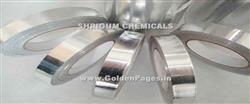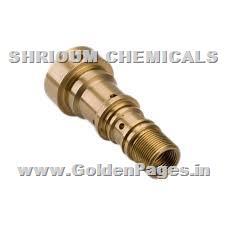SHRIOUM CHEMICALS
Featured Products
Highest quality standards are achieved through the implementations of latest technology, decades of experience and everlasting moral values , which have helped us to retain our customers as well as multiply them.
Welcome to SHRIOUM CHEMICALS
Stainless Steel Passivation

The process specified is to "pickle and passivate" - a two step method - in order to create a surface on stainless steel that would be resistant to corrosion. Pickling (or Chemical Descaling) is done to remove scale and open active surface for Passivation
. Passivation is done to make the surface more passive and corrosion resistant by loosing its chemical reactivity. Passivation unipotentializes the stainless steel with the oxygen absorbed by the metal surface, creating a monomolecular oxide film. Passivation is the formation of a hard non-reactive surface film that inhibits further corrosion. This layer is usually an oxide or nitride that is a few atoms thick.
Passivation is performed when free iron, oxide scale, rust, iron particles, (free ferrite contamination ) metal chips or other nonvolatile deposits might adversely affect the metallurgical or sanitary condition or stability of the surface (corrosion suseptiblity), the mechanical operation of a part, component or system, or contaminate the process fluid.
Passivation is performed on clean stainless steel, providing the surface has been thoroughly cleaned , degassed ( confirm by ASTM approved water droplet test) and descaled.
Since the term "passivation" is used to describe distinctly different operations or processes relating to stainless steels, it is necessary to define precisely what is meant by passivation.
Passivation is the process by which stainless steel will spontaneously form a chemically inactive surface when exposed to air or other oxygen-containing environments. Steels containing more than 11% Chromium are capable of forming an invisible, inert or passive, self-repairing oxide film on their surface. It is this passive layer that gives stainless steels their corrosion resistance. again If a stainless steel surface is scratched, then more Chromium is exposed which reacts with oxygen allowing the passive layer to reform. However, if a particle of carbon steel or tool steel is embedded in the scratch then the passive layer cannot reform and corrosion will occur when the metal is wetted or exposed to a corrosive environment.
This is necessary because during handling and processing such as rolling, forming, machining, pressing, tumbling, and lapping, particles of iron or tool steel or abrasive particles may be embedded in or smeared on or into the surfaces of stainless steel components. If allowed to remain, these particles may corrode and produce rust spots, Tea Staining and yellowing on the stainless steel. This is due to the formation of a galvanic couple between two dissimilar metals that can promote a corrosive reaction. To dissolve the embedded or smeared iron and prevent this condition, as well as restore the original corrosion-resistant surface, semi-finished or finished parts are given a 'passivation' treatment.
Products :
PassiPick Pool TM
PassiPick GelTM
Aluminum Pickling

Aluminum is the 3rd widely used element in metal industry. Aluminum is light weight metal with good ductility and malleability. It is good conductor of the electricity . Aluminum is susceptible for getting attack of atmospheric air as well as the oxidizing agents.
To prevent the unequal oxidation of the aluminum the process is adopted called Anodizing. The hard anodizing is forming the hard (thick). Layer of the aluminum oxide  over the surface. This prevents further oxidation.
over the surface. This prevents further oxidation.
We provide pre anodizing chemicals which enables the aluminum surface uniformity to set the anodizing on the metal. This also removes the staining at final finish after stripping. This gives luster polish as well as the passivation effect apart from its aesthetic look.
Product Code : Lustpol - Al
Titanium Passivation

A possible limiting factor of titanium alloy application in aqueous chlorides can be crevice corrosion in metal to metal joints, gasket to metal interfaces or under process stream deposits. Given these potential crevices in hot chloride containing media, localized corrosion of unalloyed titanium and other alloys may occur depending on pH and temperature .
Though ‘Titanium” is immune to corrosive attack by salt water or marine atmospheres. It also exhibits exceptional resistance to a broad range of acids, alkalis, natural waters and industrial chemicals. in certain condition Metal get attacked. Biometrically non acceptable .
Chemical Passivation according to active standard ASTM F86-01standard practice. For Forgings for Surgical Implants. ... The pH of the solution was adjusted to 7.4±0.1 and the temperature during the test was maintained at 37±0.2ºC.
Titanium is "passive" so a separate treatment is not called out, however, it is for the medical industry and usually ASTM B600-91 is cited for cleaning and descaling of titanium. It is referenced in ASTMF86 which describes practice for prepping "metallic surgical implants." for corrosion cleaning and descaling procedure useful to producers, users, and fabricators of titanium and titanium alloys for the removal of ordinary shop soils, oxides, and scales resulting from heat treatment operations and foreign substances present as surface contaminants.
Passivation treatments provide a controlled and uniformly oxidized surface state. The Passivation leads to a dense and stable oxide film and improves corrosion resistance (decreases ion release). The Passivation procedure involves nitric acid eliminating metallic contaminants from the surface. It has however practically no influence on the overall surface topography of Titanium surface. The resulting layer of this chemical treatment is a TiO 2 film in a thickness of two to six nanometers.
Brass Passivation

alpha beta brasses alpha (Cu70Zn30)/ beta ( CusoZnso) brass
The purpose of the treatment is to clean and produce a level of Passivation of the surface of brass articles to resist staining by handling residues and atmospheric contaminants.
free from stains and have the color of the brass substrate.
It is normally intended as a final process before assembly or packaging. The Passivation films produced are extremely thin Process consist of Cleaning , Pickling , and Chromate Passivation, and hot air drying.
Based on alloy composition, end use, surface finish, We give proprietary bath solutions for total process. We had observed 5 years of shelf life for Passivated brass with our product.
Product code : CPB - 8 , PA 14, PC14 etc.
Pickling Chemical

Pickling or chemical descaling is one of several pretreatment steps available for preparing an article for further processing such as passivation or electropolishing, or to perform a superior cleaning operation of welded structures.
Prior to pickling, the heavy surface soils such as oil, grease, buffing compounds, drawing compounds, some scale, heavy rust, dye and paint markings, tape, adhesive residue and other foreign substances must be removed. This step may be accomplished by the use of alkaline cleaners, solvent cleaning, vapour degreasing, ultrasonic cleaning, steam cleaning, water-jetting, or other mechanical cleaning. Pre-cleaning is not required if oxide or scale is the only soil on the surface.
Corrosion & Pickling
Pickling is typically performed to remove tightly adherent oxide films resulting from hot-forming, heat treating, welding and other high temperature operations. Welding or heat treatment often produces complex oxides that can vary in color. All these oxides are generally referred to as "scale" and must be removed. This is Precursor step to passivation.
Where applicable, alternative mechanical methods such as blasting, shot peening, tumbling, and wheel abrading may also be performed. Abrasives containing iron should not be used. In many cases, pickling of stainless steels is performed in two steps, one for softening the scale and one for final scale removal. Over-pickling, under-pickling and pitting usually are the direct results of lack of control over process variables including acid concentrations, solution temperature and contact time. We design pickling products to achieve safety from this.
Passivation
Surface Cleaning, Chemical Cleaning , Degreasing
This Stage allows Pickling and passivation chemicals to come in contact with metal surface which has to passivate.
Pickling Process
This stage allows to itch metal surface uniformly, which is controlled itching. In this stage metal surface get activated uniformly. Should remove all sorts of contaminants including free ferrite and all sorts of scales
Passivation Process
This stage eliminates corrosion susceptibility of surface of the metals creating uniform passive layer Chemical surface conversion takes place. Surface become passive for further air - oxidation
Confirmation of Passivation ( Passivation Tests )
At this stage the passivation effectiveness must be confirmed by one or more specified test practices to qualify for certification. In case of S.S. with standard qualified tests ASTM A967-01e1 10-Oct-2001, Third party specification tests or DIN / IS / BS
Passivation Components

Surface Cleaning, Chemical Cleaning, Degreasing
This Stage allows Pickling and passivation chemicals to come in contact with metal surface which has to passivate.
Pickling process
This stage allows to itch metal surface uniformly, which is controlled itching. In this stage metal surface get activated uniformly. Should remove all sorts of contaminants including free ferrite and all sorts of scales
Passivation Process
This stage eliminates corrosion susceptibility of surface of the metals creating uniform passive layer Chemical surface conversion takes place. Surface become passive for further air - oxidation
Confirmation of Passivation ( Passivation tests )
At this stage the passivation effectiveness must be confirmed by one or more specified test practices to qualify for certification. In case of S.S. with standard qualified tests ASTM A967-01e1 10-Oct-2001, Third party specification tests or DIN / IS / BS
Our Vision
* To embrace new technologies and methods. * To give unsurpassed products and services to the clients. * To constantly look for improvement and changes.









